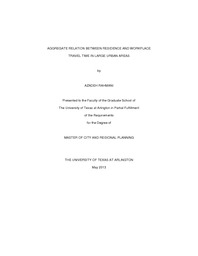
ATTENTION: The works hosted here are being migrated to a new repository that will consolidate resources, improve discoverability, and better show UTA's research impact on the global community. We will update authors as the migration progresses. Please see MavMatrix for more information.
Show simple item record
| dc.contributor.author | Rahmani, Azadeh | en_US |
| dc.date.accessioned | 2014-03-10T21:17:15Z | |
| dc.date.available | 2014-03-10T21:17:15Z | |
| dc.date.issued | 2014-03-10 | |
| dc.date.submitted | January 2013 | en_US |
| dc.identifier.other | DISS-12200 | en_US |
| dc.identifier.uri | http://hdl.handle.net/10106/24038 | |
| dc.description.abstract | The formation of urban areas is a function of locations of residence and workplaces. Urban areas grow because more residents move in the area due to economic, life style, or other opportunities. This research presents a relationship between average commuting travel time and population and land area of metropolitan areas with more than 750,000 population in the United States. The hypothesis is that in spite of significant variation among large and small urban areas, the relative residence- employment locations follows a general and predictable pattern. Forty Metropolitan Statistical Areas (MSA) are selected for the analysis. The commuting travel time is analyzed and related to population and land area to show the predictability of average home to work travel time among various MSAs. Public data sources from Federal Highway Administration and Census Bureau are presented, discussed and used. A regression estimation process is utilized and a non-linear model is produced. A validation process is applied to show the prediction accuracy of the model. Estimation and validation of the model show that average commute time can be estimated for a city within 4 minutes accuracy.The implication of this research is that the size of the metropolitan areas has small but measureable effect on the relative location of residence and workplace. Depending on the size of the metropolitan area, for each increment of 100,000 population, the average travel time to work increases between 0.05 and 0.25 minutes.The results of this research can be used in land use allocation models, transportation studies, and policy analysis. An example of the use of the developed model for policy discussion is provided. The proposed formula can estimate average commuter travel time based on population and land area of a city. Total population and area are usually available for current year and are provided in the demographic forecasting process for future years. The result of this study provides a connection between these aggregate urban characteristics and commuting travel time. | en_US |
| dc.description.sponsorship | Anjomani, Ardeshir | en_US |
| dc.language.iso | en | en_US |
| dc.publisher | City & Regional Planning | en_US |
| dc.title | Aggregate Relation Between Residence And Workplace Travel Time in Large Urban Areas | en_US |
| dc.type | M.C.R.P. | en_US |
| dc.contributor.committeeChair | Anjomani, Ardeshir | en_US |
| dc.degree.department | City & Regional Planning | en_US |
| dc.degree.discipline | City & Regional Planning | en_US |
| dc.degree.grantor | University of Texas at Arlington | en_US |
| dc.degree.level | masters | en_US |
| dc.degree.name | M.C.R.P. | en_US |
Files in this item
- Name:
- Rahmani_uta_2502M_12200.pdf
- Size:
- 9.160Mb
- Format:
- PDF
This item appears in the following Collection(s)
Show simple item record


